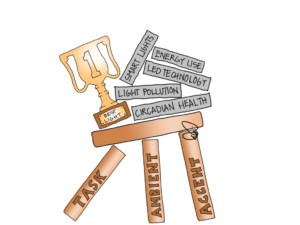*Why TASK, AMBIENT, and ACCENT should retire and make room for the next generation.
We all know people who stayed in positions of authority a little too long, folks who maybe served well in their prime but lately just seem to be preventing those with ideas and energy and enthusiasm from making much-needed positive changes.
Task, ambient, and accent layers are those people in lighting. For generations, these three layers of light have led many, myself included, towards a brighter future. But a lot has changed since they first rose to power, and their continued dominance in the classroom, in textbooks, in online training, and in articles is growing tiresome. Inspired by the uniqueness of the current presidential election cycle, I am calling for task, ambient, and accent to withdraw from the race. Real forward progress will only then stand a chance.

There is nothing inherently wrong with task, ambient, and accent layers of light. These three types of lighting sometimes go by other pseudonyms like “play of brilliants” or “sparkle,” but in any form they have held the hopes and dreams of lighting professionals, design pros, and clients for many years. As I look around me today, I see a nearby floor lamp that provides all three layers – good strong task light directed down towards the chair, soft ambient light reflected off the ceiling, and comforting accent filtered through the lampshade. So perhaps I am not asking task, ambient, and accent to retire…but to simply step backwards into an advisory role.

It is difficult to imagine our current president and his predecessor, both of whom would finish the next term in their 80’s if elected, as individuals who can relate to, say, my young adult children. I am thirty years younger than both men, yet I sit through lectures from my children on why using a period at the end of a text message is dated, passive-aggressive and not a good choice. I have a lot to offer my children and younger generations, but there are some aspects of their lives I will likely never fully understand.
The wide world of lighting has changed dramatically over the past twenty years, yet we still rely heavily on language and concepts that are older than I am. Task, ambient, and accent are still used as stand-ins for good lighting, but they struggle to encompass all the complexities of our modern approaches. Energy conservation was the primary focus of lighting design when I was starting out twenty-five years ago; an energy-first focus might render both ambient and accent lighting wasteful.
Energy conservation is simply one of many important modern design considerations. There is growing interest in preserving night skies from light pollution (and saving energy and money at the same time). Light’s impact on human health and wellbeing is increasingly well-documented, yet we struggle to change lighting to respond to the research. And we have smart light bulbs that change colors in sync with daylight; this would have been nearly impossible to achieve when I started out.
Unfortunately, task, ambient, and accent layers have to be stretched to encompass these and other newer aspects of good lighting. They just were not built to hold the future.

This example home office space features task, ambient, and accent layers of light, yet we use it as an example of not-so-good lighting. There is glare from the downlights, unwanted darkness on the shelves, and light calling attention to the cheapest, least important areas of the room at the curtain pocket. While it checks the boxes, it leaves humans less than thrilled.

The same room, illuminated with a deeper understanding of the human visual system, of human wellness, and advanced technology, appears very different. The space becomes softer, more inviting, more comfortable, with less glare even while appearing brighter. There are, to be sure, layers of light that could be labeled as task, ambient, and accent, but it is the sum of all parts that delivers the result.

Let’s give task, ambient, and accent a Lifetime Achievement Award. I am just getting old enough (or aware enough) to realize that these awards can be hurtful, in essence saying “well done, now go play golf and leave the work to the rest of us.” We will consult you from time to time, mostly out of respect for your past accomplishments and efforts, but in reality we are going to do things differently from here on out.

Someday it will be my turn to step aside. I hope I do not hold on as long as task, ambient, and accent. Relying on outdated concepts, terminology, techniques, and technologies puts the industry at risk of failure. Think I am exaggerating? Visit a brand-new million-dollar home filled with wafer lights, see the glare bomb pendants over the kitchen island, and listen to the designer talk about undercabinet task light as part of the “great lighting” in the home.
Today’s lighting world would be nearly unrecognizable by the first users of task, ambient and accent. They would be astounded by our ability to submerge lights in the bottom of flower vases, by the proliferation of solar novelties that litter our landscapes, by light bulbs you can talk to and strip lights that can party.
I believe that the people who created task, ambient, and accent lighting as our playbook, if they were still around today, would urge us to vote for the new team.
